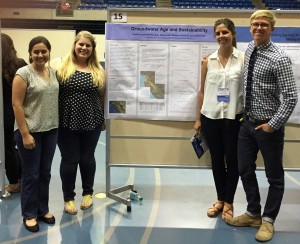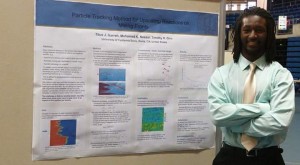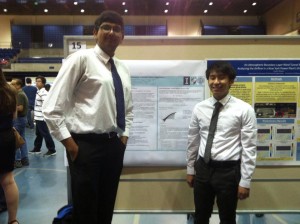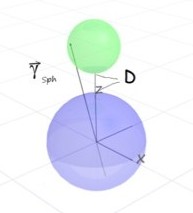Winter/Spring 2015 Undergraduate Research Projects.
1. Madison Rasmus, Amy Naumovski, Elena Tomsen, Austin Lemire-Baeten (with Prof. Ginn and Dr. Bryant Jurgens/USGS), Groundwater Age Distributions in the Salinas Valley, CA. One measure of groundwater sustainability is the time it takes to replenish groundwater in a given aquifer system, and this is characterized by the groundwater residence-time distribution, or “age distribution.” In this project, water samples collected and analyzed by the USGS were used to identify the groundwater age distribution for a select set of wells in the Salinas/Monterey Valley in California. Specifically, Carbon-14, Tritium, and Helium-3 concentration in the water samples from 6 wells were used to determine the parameters (and thus the shape) of the age distribution of the water from the 6 wells. The distributions were assumed to be of “shifted exponential” form, and the results are shown in the left panel below. The distributions generally show increasing mean and variance of age with distance downstream the valley, with occasional departures from this trend that we think is due to lateral recharge from local streams and/or local recharge of “young” water. The team presented their research results at the 2015 UC Davis Undergraduate Research Conference on 1 May as shown below.
2. Titus Garrett (with doctoral student Mohamed Nassar and Prof. Ginn) Lamella Approach for Upscaling Reactive Transport in Heterogeneous Porous Media. Groundwater remediation often is approached by injecting one solution in order to induce biochemical reactions with the solution already present in the groundwater. Another approach, “natural attenuation” involves reactions between an invading plume of contaminated water and the naturally-occurring groundwater already present. Understanding these and other cases involve characterizing the biochemical reactions that occur at the mixing front between two solutions that are moving together in a flow field that is spatially variable, i.e., nonuniform. This is shown in the left panel below where solution B is displacing solution A in a stratified flow. We are working on a way to figure out the total extent of the reaction between solutions A and B by keeping track only of the length of the interface between the two solutions. Our approach involves discretizing the interface into a series of linear segments, called “lamellae”, and solving the combined reaction and kinematics of stretching and diffusion on each lamella, so that we can calculate the total reaction rate by simply summing the reaction over each lamella. This new upscaling method is promising for any displacement problem. Titus presented this work at the 2015 UC Davis Undergraduate Research Conference on 1 May as shown below. This work is supported under NSF/EAR 1417495 A practical upscaling of subsurface reactive transport 2014-2017.
3. Arjun Natarajan, Biochem, and Daniel Nguyen, Physics (with Prof. Ginn and Prof. Helen Nguyen/UIUC) Horizontal Gene Transfer Hotspots in the Environment. The increasing occurrence of antibiotic-resistant bacteria is just one of several phenomena that are now known to be in part facilitated by the horizontal, as opposed to vertical, transfer of genes. Horizontal gene transfer involves cell-to-cell exchange of genetic material that can convey not only antibiotic resistance, but in fact any metabolic or physiological activity, including metal-tolerance, degradation ability, and others. In fact the current leaves on the tree of life exhibit similar genes across species that can only have occurred through horizontal gene transfer (figure below). In this project we examined the role of “transformation” that is the pick-up of naked DNA in the environment by viable cells, and the potential hotspots in the environments where this sort of horizontal gene transfer can occur with alarming frequency. Arjun and Daniel presented this work at the 2015 UC Davis Undergraduate Research Conference on 1 May as shown below. This work is supported under NSF/EAR 1114257 Collaborative Research: Horizontal Gene Transfer in Porous Media: Experiments and Modeling 2012-2014.
4. Arturo Palomino, CEE (with Prof. Ginn) Exact Total Force Expressions for Body-Body Interactions. A very wide range of fields in science and engineering involve calculating the forces between two bodies. These include gravitational forces between bodies, electrostatic interactions between colloids and charged surfaces, bacterial attachment to surfaces in medical and hydrogeological contexts, and others. The well-known DLVO theory of colloid stability is entirely dependent on such calculations, that are universally based on the equally well-known Derjaguin approximation that represents each (assumed spherical) body as a sum of forces between planar rings, where the spherical shape is replaced with a terraced set of rings like one sees on a roof of a rotunda. Arturo figured out a way to use spherical coordinate transformations (figure below) to exactly represent a general form of the interaction force in terms of a basis of point-to-point forces between different points on the two interacting bodies. His results reduce to the classical ones under the appropriate conditions, and give a new powerful approach for non-spherical bodies and non-uniform force densities. This work is supported under NSF/EAR 1215756 Collaborative Research: Near-Surface Repulsion and Mixing-Limitations: Upscaling of Colloid Transport in Non-Uniform Media under Unfavorable Conditions 2012-2014.
5. Cassandra Wang, CheE (with master’s student Andrew Benjamin and Prof. Ginn) Generalized DLVO modeling of Atomic Force Microscopy Data Involving Silica and Quartz Surfaces. Colloid-surface interactions resulting from surface charges control colloid stability, filtration of particles, and microbial transport. Here Cassandra and Andrew work on fitting standard models of the electrostatic interactions between colloids and surfaces using classical DLVO theory, to data from atomic-force microscopy studies of quartz-quartz and quartz-silica interaction forces in the lab of co-PI Helen Nguyen of UIUC. They found a way to modify the representation of the Stern layer to incorporate pH-dependent variations from the classical DLVO theory to better fit the AFM data. One such force profile (as a function of separation distance) is shown below. This work is supported under NSF/EAR 1215756 Collaborative Research: Near-Surface Repulsion and Mixing-Limitations: Upscaling of Colloid Transport in Non-Uniform Media under Unfavorable Conditions 2012-2014.
6. Brandon Weaver, Eng (with Prof. Ginn) Distinguishing Proper vs. Coordinate Time in Relativistic Mechanics Using Exposure-Time Dimension. Relativistic mechanics, including kinematics, has made it into the popular media especially recently through the movie Interstellar, that highlights the way that time local to a traveler moving near light speeds increments more slowly than time “back home.” The same thing happens for timekeeping by a traveler who enters a strong gravitational field. This is called “time dilation,” and the purpose of this project is to configure kinematic equations for moving bodies in such a way that both proper and coordinate times are present and accounted in the governing differential equations. We approach this by keeping track of exposure of the traveler to the time-dilating condition (fast velocity, or big gravity), using an additional dimension in the motion equation.
7. Negina Ayar and Simon Pan, CEE (with Prof. Ginn and Prof. Steffen Mehl/CSU Chico) Mapping Thomas Meadow for Hydrologic Modeling Prior to Streamflow Restoration Project. State land managers are involved in “stream restoration” in various watersheds in the Sierra Nevadas, involving creation of artificial ponds to create enhanced wetlands. This is called the “pond and plug” approach. One such watershed is the Thomas Meadow in the northern Sierras, and because it is already fully instrumented with hydrological monitoring devices, it provides an ideal opportunity to observe and characterize the impact of the pond and plug technology on the overall hydrologic cycle and dynamics of a mountain watershed. In this project Negina and Simon are building digital maps of the properties of the watershed necessary for the construction of a complete surface-water/groundwater model of the area.













